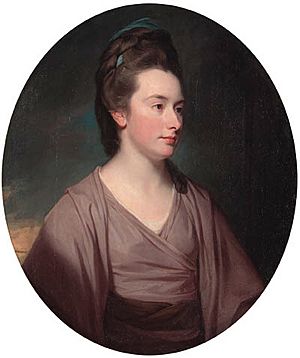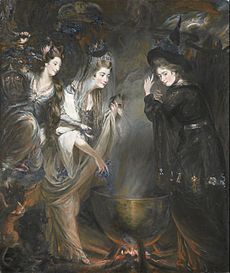Elizabeth Lamb, Viscountess Melbourne facts for kids
Quick facts for kids
The Viscountess Melbourne
|
|
|---|---|

Portrait by George Romney
|
|
| Born |
Elizabeth Milbanke
1751 |
| Died | 6 April 1818 (aged 66–67) |
| Spouse(s) | |
| Children | 9, including:
|
| Parent(s) |
|
| Relatives |
|
Elizabeth Lamb, Viscountess Melbourne (born Elizabeth Milbanke; 1751 – 1818) was a very important woman in British society. She was known for hosting many influential people. She was married to Peniston Lamb, 1st Viscount Melbourne, a politician from the Whig party.
Elizabeth was also the mother of William Lamb, 2nd Viscount Melbourne. He later became the Prime Minister of the United Kingdom. She had several other children who also became important figures. Lady Melbourne was well-known for her social influence and her friendships with other powerful people in England.
Early Life and Marriage
Elizabeth Milbanke was born in 1751. She was baptised on October 15 in a village called Croft-on-Tees. This village is in North Riding of Yorkshire, England. She was the youngest child and only daughter of Sir Ralph Milbanke, who was a Baronet. Her mother was Elizabeth (born Hedworth).
Elizabeth had two older brothers. Her eldest brother was Ralph Noel, who also became a politician. Her family lived at Halnaby Hall in Yorkshire. Elizabeth's father was a politician, and her grandfather was John Hedworth, a Member of Parliament. Elizabeth was taught at home and learned French and how to write poetry.
Her mother passed away in 1767. Two years later, in 1769, Elizabeth met Sir Peniston Lamb. They got married in London on April 13. The couple lived in a grand house called Melbourne House in Piccadilly, London. Elizabeth quickly became a popular person in London's Whig social circles.
In 1770, Peniston was given the title of Lord Melbourne. This made him a member of the Peerage of Ireland. In 1781, he became Viscount Melbourne. Besides Melbourne House, the family also had country homes. These were Brocket Hall in Hertfordshire and Melbourne Hall in Derbyshire.
Social Influence and Family

From the beginning of her marriage, Lady Melbourne was very clever. She made important friendships that helped her social standing. These friendships also helped her husband's career. She was very intelligent and understood how society worked. People said she knew a lot about the world around her.
Lady Melbourne was a dedicated mother. She worked hard to help all her children succeed, especially William. It was said that few children had a better mother. William himself called his mother "the most sagacious woman" he had ever known. He also said that "she kept me straight as long as she lived."
After 1774, Lady Melbourne became a close friend and advisor to Georgiana Spencer, who married the Duke of Devonshire. Lady Melbourne had been a very successful hostess before this. She quickly realized that the young Duchess, who had a higher social rank, would be a valuable friend.
The two women, along with their friend, the sculptor Anne Damer, were painted together. The painting by Daniel Gardner in 1775 was called Witches Round the Cauldron. Lady Melbourne also appeared as a character in the Duchess's novel, The Sylph.
Lady Melbourne did not get along well with the Duchess's sister, Henrietta Ponsonby, Countess of Bessborough. This dislike later extended to Henrietta's daughter, Lady Caroline Lamb. However, Lady Melbourne was very practical. She did not let her dislike stop her from supporting her son William's marriage to Caroline. This marriage was a good social step for the Lamb family. At the time, they were still considered new to high society.
In 1782, Lady Melbourne met George, Prince of Wales. This happened when she visited her son Peniston at Eton College. This friendship helped Lord Melbourne. He was made a Gentleman of the Bedchamber to Prince George. This was an important position at Carlton House.
Later in her life, Lady Melbourne became friends with the famous poet, Lord Byron. She became his trusted friend during his relationship with her daughter-in-law, Lady Caroline Lamb. Even though she approved of her son's marriage for social reasons, Lady Melbourne strongly disliked Caroline. Their relationship was always difficult. However, she liked Byron and did not blame him for his relationship with Caroline. Byron later married Lady Melbourne's niece, Anne Isabella Milbanke.
In 1815, Lord Melbourne was made a peer of the United Kingdom. He became Baron Melbourne of Melbourne. Lady Melbourne passed away on April 6, 1818, at Melbourne House. She died from rheumatism, a painful illness. Her slow and difficult death greatly saddened her loved ones. Even on her deathbed, she encouraged her daughter Emily to be loyal to her partner, Lord Palmerston. Emily and Palmerston later married after her husband, Lord Cowper, died. Lady Melbourne's husband lived until 1828.
Children
Lady Melbourne had six children who lived past childhood. She also had infant twins who died in 1788. Her youngest daughter, Harriet, died in 1803 at age 14 from consumption. Her son Peniston also died from the same illness in 1805, at age 34.
- Hon. Peniston Lamb (born May 3, 1770 – died January 24, 1805)
- Elizabeth Lamb (born October 25, 1777)
- William Lamb, 2nd Viscount Melbourne (born March 15, 1779 – died November 24, 1848)
- Frederick Lamb, 3rd Viscount Melbourne (born April 17, 1782 – died January 29, 1853)
- Hon. George Lamb (born July 11, 1784 – died January 2, 1834)
- Emily Lamb, Countess Cowper (1787–1869)
- Harriet Lamb (1789–1803)

